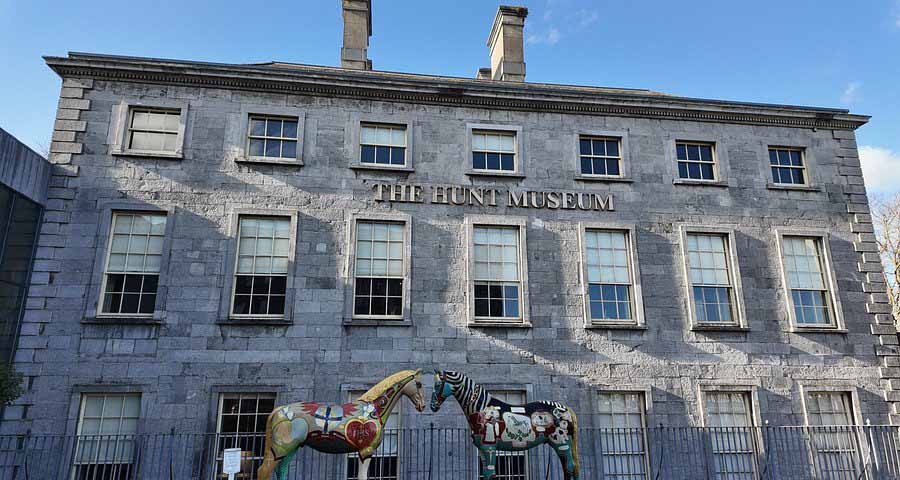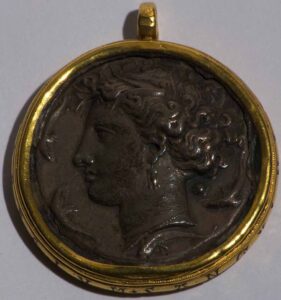
The Hunt Museum, located in the heart of Limerick City, County Limerick, is one of Ireland’s premier cultural institutions, renowned for its eclectic and internationally significant collection of over 2,500 art and antiquities. Housed in the elegant 18th-century Customs House, a Palladian-style building designed by Davis Ducart, the museum showcases the private collection of John and Gertrude Hunt, passionate antiquarians with a particular interest in medieval objects. Situated on the banks of the River Shannon, it offers a rich, immersive experience for what Tourism Ireland marketing department calls the “culturally curious”, art enthusiasts, and families.
The Hunt Museum’s collection spans 10,000 years, from the Neolithic period to the 20th century, reflecting the Hunts’ diverse tastes. Highlights include:

- Ancient Artifacts: Neolithic flints, Bronze Age shields and cauldrons, Egyptian clay falcons from Luxor, and Olmec civilization pieces from Mesoamerica.
- Medieval Treasures: The 9th-century Antrim Cross (bronze and enamel), statues in stone and wood, painted panels, jewelry, enamels, ivories, ceramics, crystal, and crucifixes. The dekadrachm (ten-drachma) of Syracuse is reputed to be one of the so-called thirty pieces of silver paid to Judas for betraying Christ.
- Fine Art: Works by Pablo Picasso (small sketch), Pierre Auguste Renoir (half-finished sketch), Paul Gauguin, Jack B. Yeats, Roderic O’Conor, Robert Fagan, and Henry Moore. A bronze horse designed by Leonardo da Vinci for a monument is a standout.
- Decorative Arts: 18th- and 19th-century silver, glass, ceramics, Japanese porcelain, and Ming vases.
- Unique Display Style: Unlike chronological museum layouts, exhibits are juxtaposed across eras—Bronze Age, Viking, Christian, and Egyptian artifacts sit alongside Impressionist sketches—creating a refreshing, non-linear journey. Visitors can open drawers to discover hidden gems, a hands-on feature rare in museums.
- Historical Context: The collection, donated to the people of Ireland by the Hunts in 1976, reflects their roles as antique dealers and advisors to Sotheby’s, William Randolph Hearst, and the Aga Khan. Originally housed at the University of Limerick in 1978, it moved to the Customs House in 1997, a partnership involving the Hunt Museum Trust, Limerick City, and the University of Limerick.
- Self-Guided and Guided Tours: Visitors can explore independently or join regular guided tours (1 hour, included in admission), led by expert volunteer docents like Brendan or Mike, praised for their knowledge, humor, and engaging storytelling. Guided tours cover 10,000 years of history, highlighting key artifacts and the Hunts’ legacy. Group tours (5+ adults) require pre-booking at bookings@huntmuseum.com, with special rates for tour operators. Tours start 10 minutes after arrival, and docents often approach visitors to share insights.
- Interactive and Family-Friendly Features: The museum’s compact size (three floors, a basement, and a gallery) prevents “culture fatigue.” Interactive elements include a virtual reality show, a ceramic exhibition in the basement, and an interactive world map. Kids’ activities, arts and crafts classes, and summer camps make it family-friendly, with docents tailoring tours for younger visitors. The “Museum in a Garden” features a sculpture trail and garden games overlooking the Shannon.
- Temporary Exhibitions: The purpose-built exhibition gallery hosts rotating displays of local, national, and international significance. Past exhibitions include “Lavery & Osborne: Observing Life” (19th-century Irish artists) and “Best Costume Goes To…” (Irish film and TV costumes), offering fresh content every few months.
- Seeing Without Sight Project: Launched in 2023, this award-winning initiative enhances accessibility for visually impaired visitors. Using Museum in a Box technology, visitors can touch 3D-printed replicas of artifacts (e.g., eight high-quality objects printed by the University of Limerick) while listening to audio descriptions co-created with visually impaired participants. Large-format and Braille labels, height-adjustable sensory desks, and screen-reader-compatible panels ensure inclusivity, earning the 2023 Heritage Council Inclusive Event Award.
Practical Details:
- The Customs House, Rutland Street, Limerick City, V94 EV8A, in the cultural district, a 5-minute walk from King John’s Castle and Saint Mary’s Cathedral. It’s 18 km from Adare, 55 km from Shannon Airport (40-minute drive), and accessible via Bus Éireann from Limerick’s Colbert Station.
- Operating Hours: Tuesday–Saturday, 10:00 AM–5:00 PM; Sunday, 11:00 AM–5:00 PM; closed Mondays except for group bookings. Free admission is offered every Sunday afternoon, a pioneering initiative to engage locals.
- Admission: General admission is €10 (online: €7.50), €5.50 for concessions (unemployed, students, over 65s), free for children under 16 and carers assisting visitors with additional needs. Adult group tickets (5+) are €5.50 per person. The Discover Limerick Pass includes the museum, offering savings with other attractions. Book at www.huntmuseum.com.
- Fully wheelchair-accessible with a lift, accessible toilets, and sensory stations for visually impaired visitors. Free admission for carers ensures inclusivity. Contact +353 61 312833 for specific needs.
- Amenities: The Hunt Café, with river views, serves leisurely lunches, quick snacks, and locally sourced dishes, though reviews suggest variable food quality. The gift shop offers high-quality Irish gifts, jewelry, ceramics, toys, and books. Free parking is limited nearby; Arthur’s Quay car park is recommended.
- A self-guided visit takes 1–1.5 hours; guided tours extend to 2 hours. Adding café or garden time makes a 2–3-hour experience.
- Nearby Attractions: King John’s Castle, Saint Mary’s Cathedral, the Treaty Stone, and Limerick City Museum are within walking distance. Foynes Flying Boat Museum (35 km) and Lough Gur Visitor Centre (21 km) are short drives away.
Atmosphere and Appeal:
- Housed in the Palladian-style Customs House, the museum exudes elegance, with its Georgian architecture and riverside setting creating a serene backdrop. Visitors describe it as “small but mighty,” with a “spellbinding” collection that avoids overwhelming, earning Tripadvisor’s Travellers’ Choice Award. The eclectic mix—from a Judas coin to Picasso sketches—appeals to diverse interests, while the friendly staff and docents add warmth. Its community outreach, including workshops and free Sunday access, fosters strong local ties.
- Sise Expectations: The museum’s compact size may surprise those expecting a larger institution, but its curated displays are a strength, preventing fatigue.
- Tour Availability: Volunteer-led tours depend on docent availability, and some visitors report missing out. Booking in advance ensures a tour.
- Monday Closure: The Monday closure (except for groups) frustrates some, so plan accordingly.
- Expanded Accessibility Initiatives: Building on the success of the Seeing Without Sight project, which won the 2023 Heritage Council Inclusive Event Award, the museum will further its accessibility efforts. The Museum in a Box technology, with 3D-printed replicas and audio descriptions, will be expanded to include additional artifacts, augmenting tactile and auditory engagement for visually impaired visitors. New workshops with disability groups in Ireland’s Midwest, facilitated by the Rapid Innovation Unit at the University of Limerick, may introduce more Braille labels or sensory stations, reinforcing the museum’s commitment to inclusivity.
- Hunt Strategy 2025 Implementation: The museum’s strategic plan, outlined in its 2025 vision, emphasizes education, community engagement, and creative reuse of its collection., expect new educational programmes, such as art and history workshops for schools, leveraging the museum’s public domain objects. Community outreach will include additional docent-led tours and volunteer opportunities, with a focus on inspiring young minds through art and imagination. The plan also hints at digital enhancements, including an updated online collection portal or virtual tours, aligning with global museum trends.
- Event Details Pending: The opera exhibition’s scope and schedule await confirmation. Visitors should monitor www.huntmuseum.com or contact +353 61 312833 for updates.
A visit to The Hunt Museum offers a exploration of 10,000 years of art and antiquities, from Neolithic flints to Picasso sketches, housed in the stunning Customs House. With self-guided or docent-led tours, interactive exhibits, and family-friendly activities, the 1–2-hour experience suits diverse interests. The award-winning Seeing Without Sight project ensures accessibility, while the Hunt Café and gift shop add convenience. New, a Limerick Opera Festival exhibition, expanded accessibility initiatives, and the Hunt Strategy 2025’s educational programmes enhance its appeal, supported by Limerick’s tourism growth. Book tickets at www.huntmuseum.com, arrive early for tours, and check for exhibition updates. For inquiries, call +353 61 312833.



